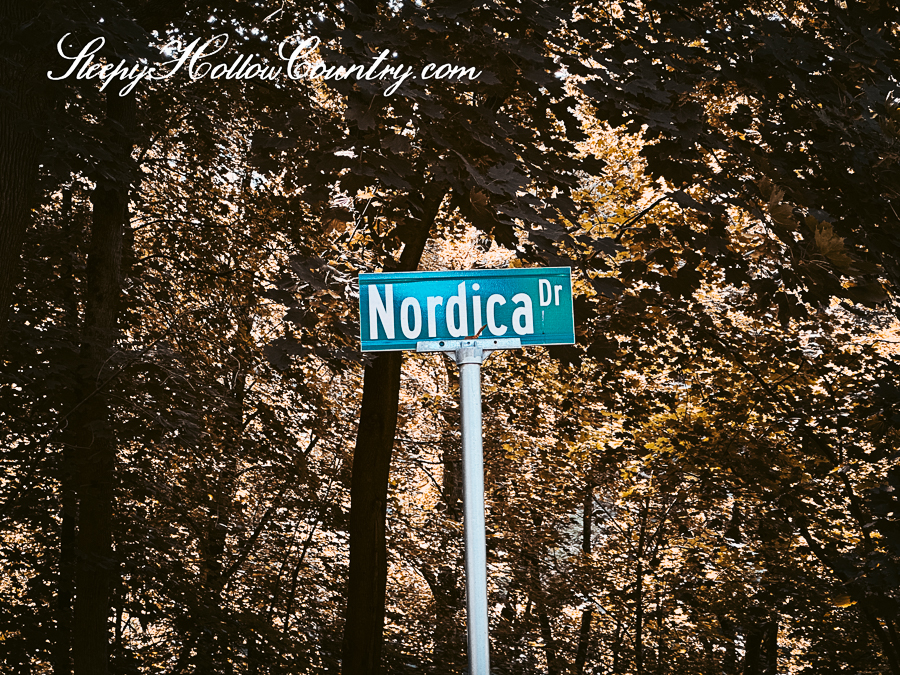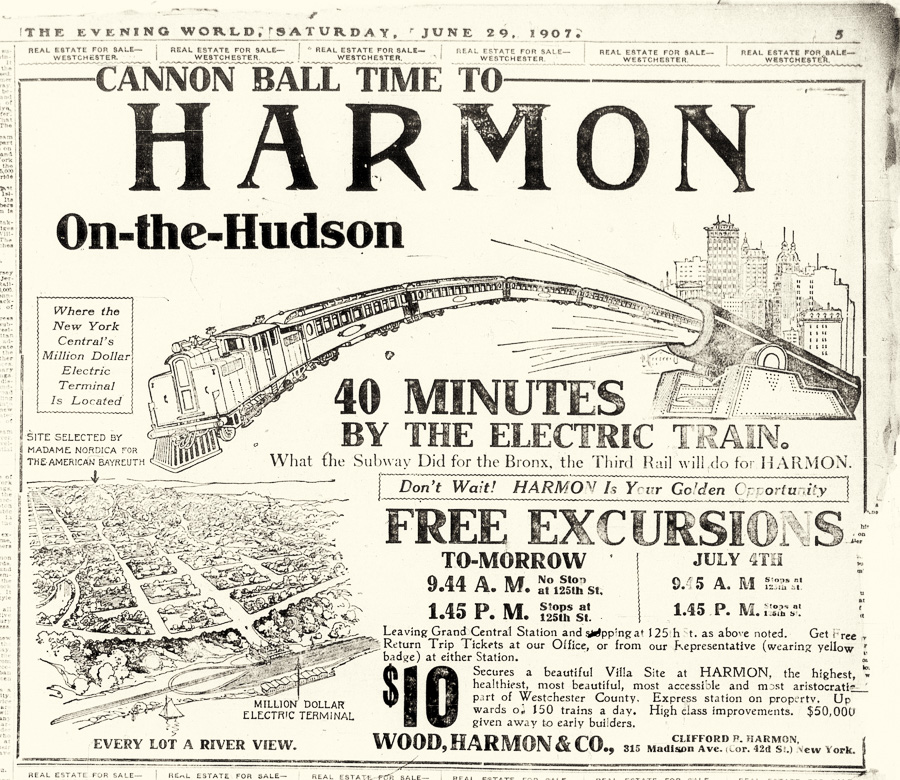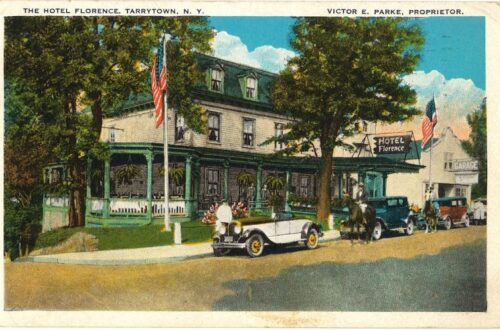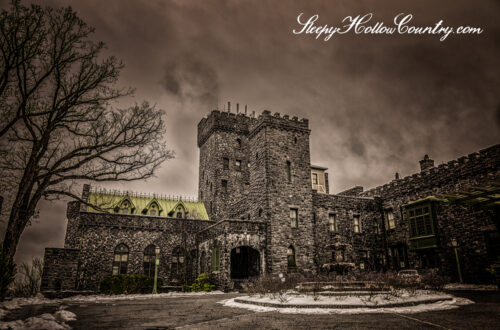
The Passionate Phantasms of Croton-on-Hudson
The following story is a particular treat for Sleepy Hollow Country. This decades-spanning tale features some incredible facts: a charming adventurer, a renowned opera singer, tragic deaths, no less than four possible ghostly “phantasms”, two separate seances, and a famed ghost hunter; all wrapped up somewhat neatly in a beautiful and unassuming stone mansion located in the quaint community of Croton-on-Hudson.
Contents
Clifford Burke Harmon

Clifford B. Harmon is just the character for a ghost story. Larger-than-life, this entrepreneur, developer, and dashing Edwardian Era wild child deserves a more thorough exploration all to himself. Still, for the sake of brevity, we will hit the best points.
Harmon was born in Ohio in 1866, and at the tender age of 21, he and his older brother established a real estate development business with their Uncle and went by the name of Wood, Harmon, & Co. Their business model of low-payment, affordable housing and building lots was so successful that they rapidly spread across the country. By the turn of the 20th century, Wood, Harmon, & Co. were building in Brooklyn and other New York Metropolitan areas.

But, this family business proved to be semi-short-lived and the three went their separate ways in 1907. Clifford B. continued on his own, as Harmon & Co., and continued work developing an artists colony known as Harmon-on-Hudson.
Outside of his business endeavors, Harmon had adrenaline-inducing pursuits; he raced horses and cars, was into yachting, and was the sixth person in the country to obtain an aviator’s license, after learning to fly after only a week of lessons in 1907. He was also very keen on ballooning and participated in races across the country; getting shot at, crashing, and breaking records (including his own) over many years. The same went for his amateur aviation career, he was constantly outdoing himself. A rash of accidents and storms ended his forays to the sky in 1911, but it was hard to keep him out of the cockpit and he would dabble well into his 60s.
Harmon was married twice, divorced twice, and engaged twice. He traveled in southeast Asia, fought in World War One, saved himself from accidental poisoning, and got into fistfights. Life caught up to him eventually, and at the age of 73, he suffered a stroke at his home in the south of France where he was ultimately housebound. Some accounts suggest he died at the hands of Nazis, but his condition allowed him to be left alone during the war.
Clifford B. Harmon died in 1945 at the age of 79. Too soon for such a man.
Artist’s Colony & An American Diva

Clifford Harmon purchased land that belonged to the Van Cortlandt Manor and began the development of a community there. The area was already a burgeoning area for artists and creatives in the wooded hills alongside the river and Harmon’s notoriety in society seemed to attract more celebrity clients to the area further. Many street names and places there today echo this early establishment and Harmon’s connection.

One such creative tasking Harmon with the building and development of 20 acres, was America’s First Diva, opera singer Lillian Nordica, or Madam Nordica. She had big plans to not just live in Harmon-on-Hudson, but build a grand opera house and a school. It was rumored that she was a lover of the playboy Harmon, and her own life had parallels to Harmon’s and her dramatic opera characters.
She married unhappily three times (one husband vanished and likely died in a ballooning accident), was heavily involved in women’s suffrage, and was friends with other artists and creatives like Douglas Fairbanks and dancer Isadora Duncan (who met her own tragic end). Clifford got as far as building Nordica a low and rambling fieldstone house, which contained a theater where she would entertain her party guests, but her other goals were never realized as she died in 1914 in Indonesia after a long illness brought on by catching hypothermia when the ship she was traveling on was run aground.
Harmon-on-Hudson was absorbed by the nearby Croton-on-Hudson. Many of the streets and place names reflect this period in history and into the 20th century it continued to thrive and be a respite for those in the arts, a legacy just as much as persistent as a poltergeist.
The Whistling Ghost
Fast forward to the 1950s, a semi-anonymous Mr. and Mrs. K occupied Nordica and Harmon’s stone residence and found that something odd was happening around them that defied their attempts to solve and rationalize. Mr. K would be awakened at night, hearing rappings and knocking about the house, but when confronting the noises, could discover no cause. Mrs. K found that she would always hear someone whistling an upbeat tune throughout the houses’ halls and reportedly secret passages. If it wasn’t herself or her husband, then who could be?
The haunting caught the attention of famed Austrian-American Parapsychologist, Hans Holzer and it was decided that the noisy specter (or specters) had to be that of either Clifford Harmon or Nordica, who both lived such full lives and had the opportunity to have unfinished business on this mortal plane. Holzer immediately planned to hold a seance in the house to get answers.
“I had heard enough. The classic pattern of the haunted house was all there. The ghost, the unfinished business, the willing owners. I offered to hold a “rescue circle” type of seance, to make contact with the “whistling ghost.””
Hans Holzer, America’s Haunted Houses, 1991.
A Clairvoyant and psychometrist, a trance medium, and Holzer all convened with the owners of the Harmon House on August 3rd, 1960. As the session began some of those present began to hear heavy breathing in the room around them and the medium eventually began to channel someone else, a man, and the title of a jaunty tune slipped from their lips.
Mrs. K confirmed it was the title of the song that the tune belonged to she heard whistled up and down her house by the entity. Once the seance ended, everyone attending departed for the night. But things would not be over yet, the owners confirmed that activity in the house had increased for them, being awoken several times in the night when their bedroom lights would turn on and the drapes moved on their own accord. But after that? Silence once again came to Harmon House.
That is until a few months later, when the Phantom Whistler returned, louder than ever in the middle of the night. It woke up both Mr. and Mrs. K and as they went to investigate, the Mrs. saw an eerie white mist levitating in the middle of their living room. Mr. walked right through it to turn on a lamp and the episode ended. The ghosts had moved on.
The Phantasm Returns

Sliding ahead another decade brought new owners to Harmon House. They knew of the stories of the Whistling Ghost, Mr. Holzer, and the seance, it was an amusing anecdote for the historic home, and it tempered their surprise when shortly after they moved in, they saw a white figure standing outside their window one evening and the lights flickered, as if it was announcing itself and saying “Hello”.
The next month, a sense of anxiety and stress clung to the owners as they sat in their dining room. They immediately attributed it to the presence of the ghost. Another episode of gloom resulted in discovering pots and pans in a kitchen cupboard to be filled with water, with no evidence of a leak to claim responsibility. This was just the start.

Lights would be found on, mirrors would be tossed to the floor or smashed to bits, doors that were locked were found to be unbolted, and that heavy sense of dread seemed to fill the rooms. This was not the carefree ghost of a whistling Harmon but seemed to be something else entirely. The owners grew concerned and tracked down the originator of the first seance: Hanz Holzer.
It was decided another seance was necessary. Holzer, a new medium, and the owners convened to identify this new sense of unrest. An unknown female ghost made contact, admitting to the episode with the water in the pans, and her stress due to waiting for her husband and son to come home. She was not satisfied with how the owners were keeping the place clean. A second male ghost came forward and admitted to murdering his business partner and was hiding out, contributing to the sense of dread and stress. Holzer was reportedly able to convince both of these spectral characters to move on; the seance was a success and all went their separate ways.
Except for the ghosts.

Perhaps the two encountered during the seance had been set to eternal peace, but something else still lingered behind, continuing to vandalize mirrors, heaving exceptionally heavy objects, causing pictures to fly across rooms, and releasing the many pet birds in the house free of their cages but without opening and unlocking the small doors. Friends and family didn’t feel comfortable staying over for long and with a quiet resignation, the owners finally accepted their invisible and somewhat unpredictable roommate. They had been there first.
Whomever it is, has decided it wants to stay in the Harmon house. Is it Harmon himself, frustrated that he cannot continue his carefree adventures? Is it Nordica, fighting back against her untimely death and wishing to return to her glory days giving parties in her grand stone playhouse? Or is it one of a possible plethora of orphaned spectral creatives that linger in their artistic dissatisfaction? It would take another seance to find out.
Please note, the house described in this piece is a private residence and should be treated, along with its current owners, with distance and respect.
Know a ghost itching for the spotlight? Email us at ghost.editor@sleepyhollowcountry.com—because every phantom deserves their 15 minutes of fame.





